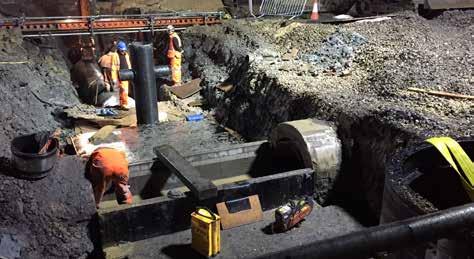
12 minute read
Resilience by design
The dramatic scene at Dawlish following the storms of February 2014.
The first section of sea wall along Marine Parade was completed in July 2020.
GRAHAME TAYLOR Railway structures have seen their fair share of violent weather over the years. Now, some of them are nearly 200 years old and yet the weather makes no concessions at all to their age. Storms continue unabated, the heavens open and inundate already saturated soils. There is no let-up. Understandably, some structures have had enough and fail. When they fail, the railway is interrupted.

In our technological world, passengers and freight customers have high expectations. They expect no interruptions; they expect railways to be resilient no matter what is thrown at them by the weather.
But perhaps it’s worth sorting out what ‘resilience’ means, particularly in the context of railway engineering. According to the internet - so it must be true! - the word has been around since the early 17th Century, coming from the Latin ‘resiliens’, the present participle of ‘reilire’ - ‘to rebound or recoil’ - which, in turn, is related to ‘re-’ - meaning ‘back’ - and ‘salire’ - ‘to jump or leap’.
These days, the meaning has become either (a) ‘the ability of a substance to return to its usual shape after being bent, stretched, or pressed’ or (b) ‘the ability to be happy, successful, etc’, again after something difficult or bad has happened. The whole system
In a railway engineering context, given that structures are rarely imbued with happiness, we have a cocktail of both (a) and (b) with ‘the ability of a substance to return to its usual shape after something difficult or bad has happened’. But even then it’s not quite right as railway structures rarely deform sufficiently for us to be relieved that they’ve returned to their original shape. It is more meaningful to consider the resilience of the whole railway system to return to its usual shape - or state - after something difficult or bad has happened.
In the end, the ‘usual state’ must refer to the timetable - to the planned and predictable running of trains to form a service for passengers and freight customers. Resilience has to extend to a multitude of railway operating tasks - locating rolling stock, train crew, rescuing stranded passengers, feeding trains back into the network in a logical manner
- but none of this will be of any use if one piece of the infrastructure has not survived the ‘something difficult or bad’.
Finally, this is where railway engineering comes in. For a timetable to be resilient, there have to be concerted efforts prior to any event to anticipate and prevent structural failures. The failures need not be catastrophic, although these are the ones that hit the headlines - Dawlish sea wall, for example. They can be minor irritations leading to precautionary speed restrictions which can often knock seven bells out of a tight timetable.
So, what role does the civil engineer have in ensuring services can rebound after heavy rain or high winds or scorching heat or months of drought?
In the high-profile cases, the railway engineer is visible mending the broken infrastructure. The stuff of multiple war stories recounted ad nauseum at engineers’ reunions. But it shouldn’t always be thus. There are engineering teams and infrastructure owners throughout the UK and beyond who focus their attention on strategic actions needed to ensure that a railway can reopen quickly and orderly when the storm has passed.
This article will look at three case studies each, in their own way, illustrating how they fit into the wider concept of railway resilience.

The harrying of Dawlish
In the case of the Dawlish sea wall failure - one of the pivotal moments in railway asset management - the task of the Arup engineers drafted in to ponder the gap in the railway was how to carry out repairs that would withstand any increasing ferocity and frequency of storm events, following the initial repairs carried out by others. The national press was quick to post images of the missing wall, but less publicised were huge holes in the boundary wall between the railway and the trackside walkway, the lifting of slabs on the promenade and the signs of further failure from the impact of the waves.
As to why the wall failed, Emma Lewis, Programme Engineering Manager, Network Rail, has pieced together the evidence. “That winter we had lots of regular stormy events that had depleted the beach. We think that the February event was a combination of a loss of the beach and then the focused impact of those powerful waves which caused a failure of the section. Waves were high enough to cause a washout behind the wall which prompted a progressive collapse.”
Arup has an extensive record of railway experience and was able to draft proposals that not only reinstated the railway in a timely fashion but also presented a solution that was based on a thorough understanding of the way that the original wall was designed and built. Fortunately, the design engineers had access to detailed records of the wall’s construction as well as contemporaneous construction accounts in Repairs have been designed to withstand the increasing ferocity and frequency of storm events.

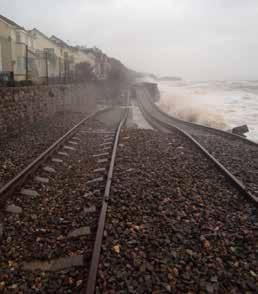

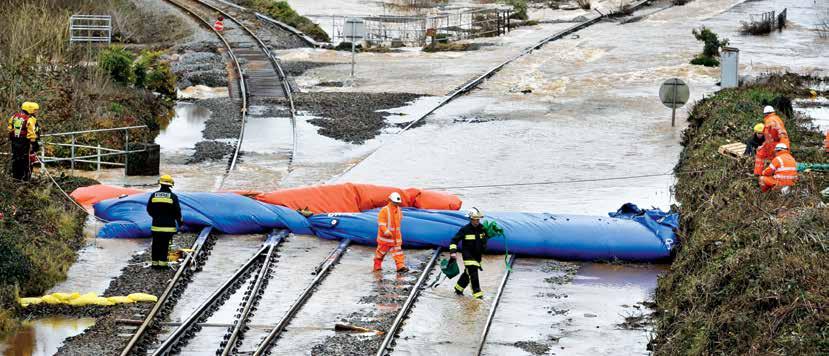
technical journals. David Morgan, Project Manager, Arup, and his colleagues further extended the trawl for information by acquiring a collection of rare text books which came via Amazon and Ebay!
Delivering a solution in extreme conditions
The pre-design investigations informed the decision to construct a new structure that was, as far as possible, independent to the old. Following on from testing and coring, the proposal was to construct a new set of foundations in front of the existing wall.
Saeed Mojabi, Project Director, Arup, and his Design Manager colleague, Rob Snell recalled, “We went through an iterative process of trying to decide what was the best solution and how best to put in new foundations. Working in a sea environment with a tidal range is quite tricky. The tidal range is not huge but it covers the beach area so you end up with only a very small amount of water covering the beach at high tide. This precluded the use of a floating barge and so the least risky option adopted was to drive piles off a jack-up barge.”
“Perhaps ‘driven’ is the wrong word. We developed something that is rarely done which was to rotate a large steel tube with a serrated base into the rock. This allowed the construction contractor to complete each element of the foundation in one operation off a barge that is independent of the tide. The jack-up arrangement can work 24 hours, around the clock, and can walk along the beach a bit like a centipede.”
“We needed to get most of the wall and all of its foundations to a depth at which it, amongst other things, can deal with a 100 years’ worth of scour. Quite a bit of science came into this in estimating how much of the beach - and indeed the rock underneath - could be lost over the 100year design life which would affect the embankment and, of course, the stability.”
Events that might initially bring havoc and disruption can in fact be a catalyst to ‘build back better’, taking the opportunity to involve and engage with communities to create solutions that consider local needs and improve facilities. At Dawlish, access to the promenade has been greatly improved, with the area underneath now buggy and wheelchair accessible. A viewing platform has also been created to allow wheelchair users a view over the sea wall and partly in acknowledgment of a nearby care home whose residents enjoy trips along the sea front.
For any reader unfamiliar with the details of the repairs, Rail Engineer’s comprehensive coverage can be found in Issue 113 (March 2014) and Issue 117 (July 2014).
South West Resilience Programme
The media covered the Dawlish event and its immediate repair, but there was much less attention to a concurrent cliff failure between Parsons Tunnel and Teignmouth. Phil Morton, Project Manager, Network Rail, takes up the story.
A study was commissioned covering all the way from Exeter to Newton Abbott, and on the estuary route, with the ambition of creating 100 years of resilience and identifying a number of interventions in those sections, with timelines of when they had to be implemented. The first two priorities were in the Dawlish area.
Phase 1 - Marine Parade - construction completed and promenade opened in July 2020; Phase 2 - Coastguard to Colonnade - currently in construction. Arup worked as designer on both of those phases. This will be followed by three further phases - a rockfall shelter at Parsons Tunnel North, cliff stabilisation between all the tunnels from Dawlish to Parsons Tunnel, and 1.8km of sea defences between Parsons Tunnel and Teignmouth. Phases 1 and 2 are coastal works; 3 and 4 are geotechnical and Phase 5 is a bit of both.
(Above) Flooding at Cowley Bridge Junction and (below) mitigation measures put in place to prevent it.
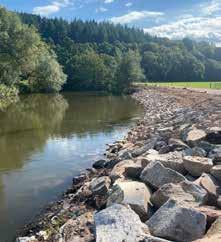

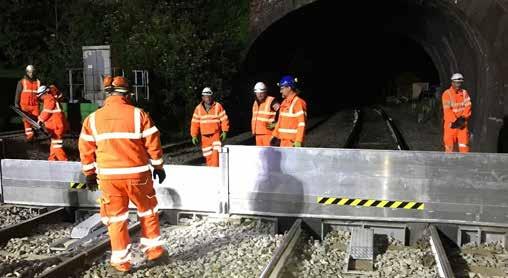
David Morgan explained that this South West Resilience Programme is a really interesting suite of engineering challenges, some of which protect the railway from the sea, some the railway from the cliffs and some of the inland schemes protect the railway from flooding. All take into consideration local ramifications - to get a balance between the requirements to keep a railway service intact at the same time as acknowledging the needs of local communities.
Arup is also involved in the Intelligent Infrastructure Programme with Network Rail. Rob Snell explains that this is all about using data and digital technologies to improve asset management decision-making. Structured data helps judge where to intervene and what to do in a timely and efficient manner. The data comes from laser scans monitoring slopes to surveys by drones and condition monitoring.
Regular flooding at Cowley Bridge Junction
Cowley Bridge Junction, on the approaches to Exeter, had a history of destructive and disruptive flooding. When the River Exe overtopped its banks - a frequent occurrence - and made full use of its flood plain, the floodwaters had nowhere to go when they reached Cowley Bridge Junction, except straight through and over the railway. This has caused closure of the line on several occasions in recent years as a result of washing away the ballast and damage to signalling cables. Rail Engineer covered this high-profile event in Issue 100 (February 2013).
Deborah Elliot, Network Rail’s Project Manager, worked on the project and outlines the complexity of the work. Recommended actions included selective lowering of the flood plain on its approach to the embankment, removal of the existing undersized concrete pipework and the replacement of a significant portion of the embankment with twin concretebox culvert sections. The intent was to provide sufficient flow capacity to prevent any erosion of the embankment or ballast, and equalise the water pressure on both sides of the embankment.
Design development by Arup to confirm the design and dimensions of the box culvert sections, along with hydraulic modelling, was carried out. This was to ensure that, over time, overall scour patterns would not be altered. A topographical survey of the flood plain was made on a five-metre grid with the use of LiDAR data. This then enabled design of the flood plain lowering scheme on the approach to the embankment and the twin culverts, sitting side by side, crossing beneath the railway at a skew angle to suit the natural flow of the watercourse.
As Saeed Mojabi recalls, “In order to meet the very challenging 72-hour possession, we opted for the unusual step of constructing culvert wingwalls before the culverts arrived on site!” And at Chipping Sodbury
Flooding at Chipping Sodbury has been disrupting the timetable of the line between Bristol Parkway and London for a number of years. This has been much less visible to the general public, although passengers were often seriously affected.
One of the reasons why the flooding here seemed to be an intractable problem was that any water pumped out of the system seemed to go on a circular tour back into the surrounding aquifers and then reappear in the tunnel! Rail Engineer’s coverage appeared in Issue 156 (October 2017).

Arup was invited to develop a water management scheme that involved the eightfold increase in the size of a lagoon that stores the flood water, attenuating the onward flow of pumped water into existing watercourses. Consultation with local residents and landowners took place to agree a protocol for emptying the lagoon as a too enthusiastic use of the pumps can lead to downstream flooding.
Measuring and modelling
The last word goes to Deborah Elliot who wryly puts forward the infrastructure owner’s defence. “We have a legacy issue here that must be recognised. When the railways were built, they didn’t always get their preferred routes or have the best land or the finest drainage.” So true. At times they were left with the junk and so there have to be constant efforts to ensure that ageing assets are inspected, assessed and maintained.
Arup’s involvement in the foregoing remedial projects have focused not only on the solution of present difficulties, but have used measuring and modelling techniques to design infrastructure that will perform reliably for at least 100 years.
With the application of science and experience, and a systematic approach to asset management, there is the real prospect of service resilience after “something difficult or bad has happened”…and maybe even the prospect of infrastructure that is “happy and successful”. A water management scheme has been implemented to resolve long-term flooding issues at Chipping Sodbury.
